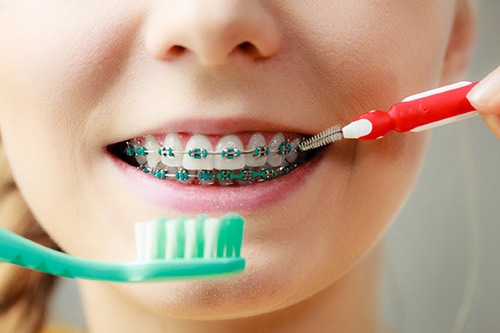How to Brush
Brushing your teeth when you have braces isn’t that much different than brushing your teeth without braces.
You still:
Use a soft-bristle toothbrush or a power toothbrush and brush for a full two minutes
Replace your toothbrush every 3 months, or sooner, since the brackets on your braces might make the bristles wear down a little faster
Brush around all the parts of your teeth, including the fronts, sides, backs, near the gumline, and chewing surfaces
Brush your tongue and the roof of your mouth
An end-rounded bristle toothbrush works well for brushing braces. Brush gently but thoroughly. If your braces look clean and shiny and if you can see the edges of the brackets clearly, you’ve done a good job!
Make sure to rinse your mouth after brushing with water or with a mouth rinse. Ask Dr. Amir Davoody for a recommendation.
How to Floss
Although flossing with braces is tricky, you can get the hang of it with practice if you follow these steps:
Use waxed floss (unwaxed floss is more likely to get caught and shred in your braces), dental tape, or a product specifically designed to clean around your braces
Use enough. About 18 inches of floss should suffice
Thread it carefully. Take the floss and carefully thread it under the main wire of the braces before passing it between two teeth. Then remove the floss and re-thread it under the main wire to pass between the next pair of teeth
Be sure not to snap the floss—simply move it up and down gently against the side of each tooth
Do the flossing for younger children who lack the coordination to thread the floss under the main wire of their braces
Emergency Care
Irritation of Lips and Cheeks from Braces
With braces, you have an appliance in your mouth that you are simply not used to. It may take a little time for your mouth, cheek, lips, and tongue to get used to their new friend.
To help alleviate some of the irritation, the assistants will provide you with relief wax.
Instructions:
Pinch off a small piece and roll it into a tiny ball
Flatten the ball and place it over the area of the braces that is causing the irritation
If the wax falls off, a piece of wet cotton wrapped around the offending attachment or even a small piece of orange peel can do the trick
You’ll be able to eat better, talk better, and feel better just by having a little buffer between your braces and your cheek or lip. If the irritation persists, please call the office. You may need a little adjustment.
What to Do If Braces Brackets Come Loose
Brackets serve as handles to hold the wire of the braces in place. Brackets are generally bonded to the teeth with adhesive. They are tough, sturdy, and stable.
But brackets can loosen if:
You eat hard, crunchy, or sticky types of food
You get hit in the mouth
That’s why you should ask Dr. Davoody about wearing a mouth guard during any and all types of physical activity.
Please know we will see our patients ASAP for a poking wire or traumatic injury if appropriate. A broken bracket, however, will be corrected at another visit during school or work hours, allowing for the “after school” rush to be seen more smoothly. If a broken bracket is to be repaired at the next visit, let us know so we can reschedule your appointment for the appropriate time.
What to Do If Braces Wires Come Loose
The arch wire of braces fits in the horizontal slots in each bracket. The wire is secured to all of the brackets, and occasionally, simply by the act of biting and chewing, the end of a wire will work itself out and cause irritation.
The best way to alleviate the discomfort is to push the wire back down:
Use a Q-tip or pencil eraser to push the wire back so it’s flat against your tooth
If you can’t get the wire back to a comfortable position, cover it with relief wax to have a buffer between your braces and the area of your mouth that’s irritated
In an extremely bothersome situation, and as a last resort, clip the wire:
Reduce the possibility of swallowing the snipped piece by putting a folded tissue or piece of gauze around the area
Use sharp clippers and snip off the wire
Use relief wax if the area is still irritated
Make a follow-up appointment with Dr. Davoody to make sure the braces are still secure and to get a different wire if necessary.

